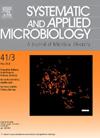通过完善的整体基因组相关指数获得的昆明杏杆菌相关菌株的鉴定结果不一致。
IF 4.2
2区 生物学
Q2 BIOTECHNOLOGY & APPLIED MICROBIOLOGY
引用次数: 0
摘要
近十年来,包括平均核苷酸同一性(ANI)和数字 DNA-DNA 杂交(dDDH)在内的整体基因组相关指数一直被用作细菌分类和鉴定的标准。另一方面,以前的一项研究表明,基于 ANI 的分类对于嗜果乳酸菌 Apilactobacillus kunkeei 来说是困难的。在本研究中,通过基于基因组的多重分析,对包括昆凯嗜酸乳杆菌(A. kunkeei)在内的嗜酸乳杆菌属的分类进行了评估。除了与A. kunkeei相关的菌株外,基于ANIb的分类能正确识别Apilactobacillus属的菌株。与 A. kunkeei 相关菌株中的一些菌株配对显示 ANIb 值接近 95 % 的阈值,因此无法对其进行鉴定。另一方面,dDDH 为 A. kunkeei-相关菌株提供了更清晰的鉴定结果,但将其细分为若干组,而这种细分的有效性尚不明确。在 ANIb 和 dDDH 中,某些菌株与多个物种级分类群的相似性超过了阈值。GTDB-Tk 将与 A. kunkeei 相关的菌株分为 6 个种级分类群,没有出现明显的混淆,而分类结果与 ANIb 和 dDDH 的结果不同。本研究凸显了用完善的整体基因组相关指数鉴定 A. kunkeei 相关菌株的不一致性,这将是细菌分类学的一个重要问题。此外,建议在基于 ANIb 和 GGDC 的分类中引入 GTDB-Tk 所采用的规则,即把菌株分类到包含相似度最高的类型菌株的类群中。本文章由计算机程序翻译,如有差异,请以英文原文为准。
Inconsistent identification of Apilactobacillus kunkeei-related strains obtained by well-developed overall genome-related indices
During a decade, overall genome related indices, including average nucleotide identity (ANI) and digital DNA-DNA hybridization (dDDH), have been used as standards for the classification and identification of bacteria. On the other hand, a former study suggested that ANI-based classification is difficult for fructophilic lactic acid bacterium Apilactobacillus kunkeei. In the present study, the classification of Apilactobacillus spp., including A. kunkeei, was evaluated by multiple genome-based analyses. ANIb-based classification appropriately identified strains of Apilactobacillus spp., except for A. kunkeei-related strains. A number of strain pairings in A. kunkeei-related strains showed ANIb values around the threshold value of 95 %, based on which they were unable to be identified. On the other hand, dDDH provided clearer identification results for A. kunkeei-related strains but segmentalized them into a number of groups, while the validity of this segmentation was unclear. Certain strains shared similarities over the threshold with multiple species-level taxonomic groups in ANIb and dDDH. GTDB-Tk classifies the A. kunkeei-related strains into six species-level taxonomic groups without marked confusion, while the classification results differed from those obtained by ANIb and dDDH. The present study highlighted the inconsistent identification of A. kunkeei-related strains by the well-developed overall genome related indices, which would be a significant concern for bacterial taxonomy. Moreover, the rule adopted in GTDB-Tk, i.e., the classification of strains to taxa containing type strains showing the highest similarity, is recommended for introduction into ANIb- and GGDC-based classifications.
求助全文
通过发布文献求助,成功后即可免费获取论文全文。
去求助
来源期刊

Systematic and applied microbiology
生物-生物工程与应用微生物
CiteScore
7.50
自引率
5.90%
发文量
57
审稿时长
22 days
期刊介绍:
Systematic and Applied Microbiology deals with various aspects of microbial diversity and systematics of prokaryotes. It focuses on Bacteria and Archaea; eukaryotic microorganisms will only be considered in rare cases. The journal perceives a broad understanding of microbial diversity and encourages the submission of manuscripts from the following branches of microbiology:
 求助内容:
求助内容: 应助结果提醒方式:
应助结果提醒方式:


